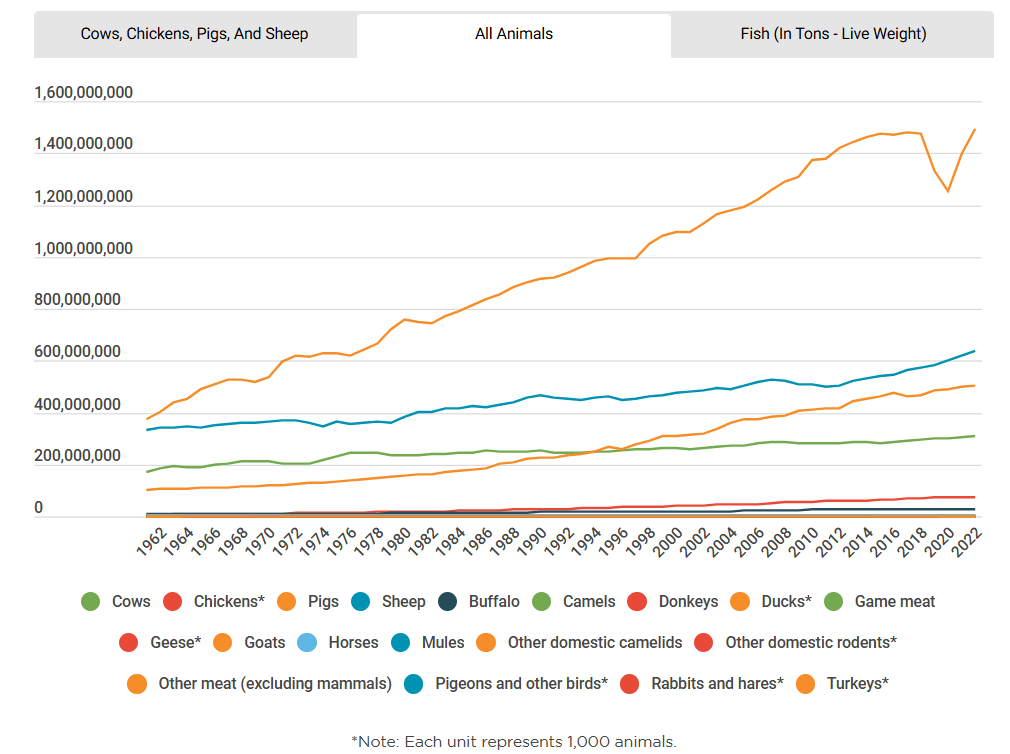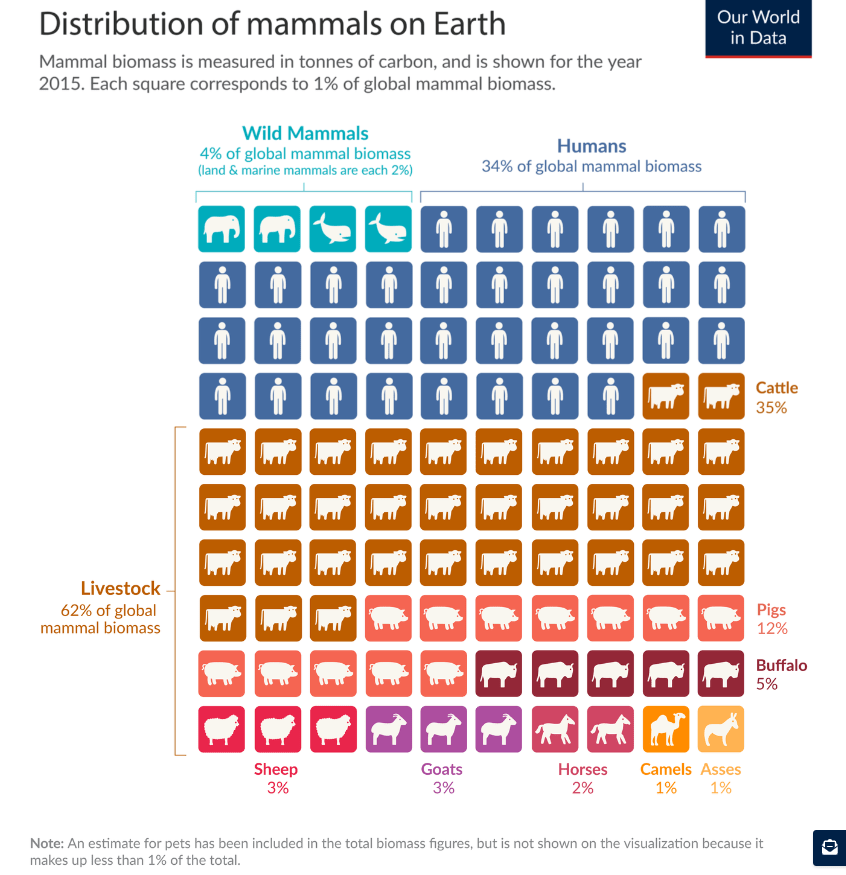The extent of animal suffering at the hands of humans is truly not comprehensible. The extent of human suffering alone is still nearly impossible to process—not to mention animal lives, who exist in far larger numbers than humans due to the intensification of industrial animal agriculture. At Faunalytics, we help the animal movement make informed decisions to improve their advocacy—we believe that many in the EA movement may find our research and data helpful to get a solid framework in understanding the animal welfare problems we are dealing with. So, let’s jump into the numbers.
In 2022, 82,624,694,782 (82+ billion) land animals were slaughtered, a number that has consistently been rising throughout the last several decades. This data is driven in part by small-bodied animals, like chickens, ducks, and other birds, who need to be killed in far higher numbers than most mammals—that’s why they cannot even be displayed correctly on this graph and must be rendered 1/1000th as small as mammals. (Source: Faunalytics’ global animal slaughter statistics). In the same year, 62.3 million humans died (Source: Our World in Data).
An excellent visualization from our friends at Our World in Data helps show this concept in a different way—by weight, animals used for food are by far the largest category of land mammal, easily eclipsing humans and wild animals. The same is true of birds, where farmed birds are twice as common as wild birds.
This horrific number does not encompass marine species, a far more difficult number to pin down because fishes are killed in amounts so vast that they are tracked by weight, not by lives. In 2021, 91.2 trillion tons of fishes were slaughtered (Source: Faunalytics’ global animal slaughter statistics).
Estimates for the number of marine individuals who are slaughtered can vary, but a report from earlier this year pegged the number at 1.1–2.2 trillion fishes caught annually. Still, this number may even be an undercount, as illegal fishing, discards and ghost fishing were not tracked. (Source: Mood et al., 2024). The total tonnage of fishes from these farms surpassed wild-caught fish in 2012 (Source: Our World in Data). There is an estimate for the number of finfishes slaughtered annually–124 billion—but this doesn’t include shrimps, so it’s almost certainly an undercount (Source: Mood et al., 2023). This is a total of 1.224 - 2.324 trillion finfishes killed annually.
When we add shrimp into the mix, the numbers start to get more dizzying–440 billion farmed shrimps slaughtered every year and 25 trillion wild-caught fish killed every year (Source: Rethink Priorities).
These numbers are big, that much is clear. But for me at least, any number that ends in an “-illion” is nearly impossible to truly understand, but we can try to illustrate the scale here with some back-of-the-napkin math:
If each human that died in 2022 (62.3 million) was converted into a second, we’d be able to stretch back nearly two years – a time when “Un Verano Sin Ti” was in its heyday.
If every farmed land animal that died in 2022 was similarly converted (82 billion), it would encompass 2,600 years, so long ago that the Ancient Greeks were in their heyday.
If all land animals and finfishes killed by humans were converted into seconds (1.85 trillion – using the middle estimate of the finfishes), it would encompass 58,663 years – so long ago that the Paleolithic Age was in its heyday.
If we add shrimp, (27.29 trillion), it would be 865,360 years – so long ago that homo erectus was in their heyday.
Finally, consider this: up to 94% of these animals are factory farmed, and most of them don’t have legal protections during slaughter or confinement (Source: Our World in Data). While it’s certainly true that the welfare of animals can vary from farm to farm, it’s difficult to imagine that any significant number of farmed animals are treated well–heck, even if a vast majority of animals used for food had relatively high welfare, the sheer scale of the numbers of farmed animals necessitates that billions or trillions of animals are still suffering from low-welfare environments. If you'd like to read more about farmed animals, I strongly recommend our infographic-heavy Fundamentals, which explores these questions with more depth.
I hope these numbers can help the community grasp the scale of animal farming, slaughter, and welfare that we’re dealing with. Finally, a plea: these scales make it quite difficult to think of these animals as individuals, not just statistics, but it’s important to remember that each of these data points is an individual being.
Now that I’ve (hopefully) illuminated the scales of animal suffering, I look forward to seeing others’ posts on the topic for this debate week as other people discuss interventions strategies, funding, and other critical topics.
If you have further questions about animal-related topics, the Faunalytics team is here to help.



Nice illustrations, Björn!
Relatedly, readers my want to check my post Farmed animals are neglected.
Based on the results of the above post, I have also Fermi estimated the disease burden of the Holocaust equals the disability of factory-farmed animals over 2.33 days.
Thanks for this post, which contains very telling information. I don't have much to add.
Regarding debate week, I saw on the forum's home page that you cast a vote for "neither agree nor disagree" to the claim that additional money would be better spent on animal welfare, but this seems to conflict with the tone of this post (I noticed this because there is only one vote like that and it didn't have a comment).
Is that voluntary?
Hello CB, I'm glad you enjoyed the post!
I don't remember casting a vote (perhaps when I clicked on my own icon it registered that as exactly being in the middle which was the default position -- I can try to undo this). As a representative of Faunalytics, I am not currently attempting to vote in the debate but rather provide information to help others make their decisions.
Understood, it makes sense.
I just wanted to say I really appreciated you illustrating the scale by translating individuals into seconds.
That really helped me wrap my head around this.
I agree this is a powerful representation of the numbers of individuals involved. Thanks!